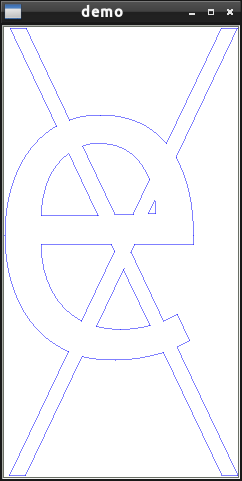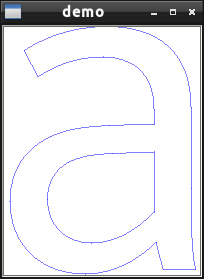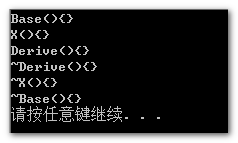计算多边形并时在CGAL中触发的断言
我正在用Python编写一个将水印应用于字体文件的应用程序。这些图形是带有孔的非凸多边形,由PostScript中定义的bezier样条组成.水印需要与符号合并,而不是重叠。我无法在Python中找到一个库来完成这个任务,所以我使用的是CGAL & C++。我让它在大多数象形文字上运行得很好,但它在其他人身上却神秘地失败了。
最初,我对CGAL印象深刻。它看起来非常全面和复杂,似乎提供了我所需要的所有功能,但是它有一个致命的缺陷--我几乎无法相信--库中没有错误处理。没有错误代码,没有异常,只有断言--但只在调试版本中。在版本构建中,您会得到一个很好的分段错误。此外,这些断言没有揭示问题的性质。
程序只在某些符号上失败。字母e工作得很好,但是它在a上崩溃了。当我试图计算字形与水印的合并时,就会发生崩溃。“a”字形没有什么明显的问题。我的应用程序正确地解析了PostScript,并在QGraphicsView上很好地呈现它。
这个程序需要在服务器上运行,它的输出直接发送给客户,所以它必须是可靠的。我无法从断言失败或分段错误中恢复,那么我能做什么呢?
即使我让它可靠地工作,我怎么能相信它永远不会失败呢?如果有某种错误处理到位,我可以跳过它失败的几个符号,让它们没有水印-不是理想的,但可以接受。我只是不明白这个库的作者们在想些什么;他们花了这么大的精力来提供最全面的几何图形库,只是为了确保它完全不适合使用。
目前看来,我需要自己修改代码,以便以合理的方式处理错误,但这似乎太荒谬了。
我很抱歉,如果我失去耐心,但我已经超过了我的最后期限,我的客户不会关心或理解这些借口。
断言失败发生在Multiset.h的第2141行:
CGAL_multiset_precondition (comp_f(object, nodeP->object) != LARGER);当我在BezierPolygonSet上调用join()时,就会发生这种情况。我的类型如下:
typedef CGAL::CORE_algebraic_number_traits NtTraits;
typedef NtTraits::Rational Rational;
typedef NtTraits::Algebraic Algebraic;
typedef CGAL::Cartesian<Rational> RatKernel;
typedef CGAL::Cartesian<Algebraic> AlgKernel;
typedef RatKernel::Point_2 BezierRatPoint;
typedef CGAL::Arr_Bezier_curve_traits_2<RatKernel, AlgKernel, NtTraits> Traits;
typedef Traits::Point_2 BezierPoint;
typedef Traits::Curve_2 BezierCurve;
typedef CGAL::Gps_traits_2<Traits> BezierTraits;
typedef BezierTraits::X_monotone_curve_2 BezierXMonotoneCurve;
typedef BezierTraits::General_polygon_2 BezierPolygon;
typedef BezierTraits::General_polygon_with_holes_2 BezierPolygonWithHoles;
typedef CGAL::Gps_default_dcel<BezierTraits> BezierDcelTraits;
typedef CGAL::General_polygon_set_2<BezierTraits, BezierDcelTraits> BezierPolygonSet;任何帮助都将不胜感激。谢谢。
编辑:
我有一个名为几何学的模块,它封装了CGAL代码,并公开了一系列几何原语(点、曲线、LineSegment、CubicBezier、路径)和函数:
PathList toPathList(const PolyList& polyList);
PolyList toPolyList(const PathList& paths);Path类有一个名为computeUnion的方法,如下所示:
PathList Path::computeUnion(const PathList& paths1, const PathList& paths2) {
PolyList polyList1 = toPolyList(paths1);
PolyList polyList2 = toPolyList(paths2);
cgal_wrap::BezierPolygonSet polySet;
for (auto i : polyList1) {
polySet.join(i);
}
for (auto i : polyList2) {
polySet.join(i);
}
PolyList polyList;
polySet.polygons_with_holes(std::back_inserter(polyList));
return toPathList(polyList);
}当我调用join()时会发生错误。多边形是由这样的路径创建的:
PolyList toPolyList(const PathList& paths) {
cgal_wrap::Traits traits;
cgal_wrap::Traits::Make_x_monotone_2 fnMakeXMonotone = traits.make_x_monotone_2_object();
cgal_wrap::RatKernel ratKernel;
cgal_wrap::RatKernel::Equal_2 fnEqual = ratKernel.equal_2_object();
PolyList polyList; // The final polygons with holes
cgal_wrap::BezierPolygon outerPoly;
std::list<cgal_wrap::BezierPolygon> holes;
std::list<cgal_wrap::BezierXMonotoneCurve> monoCurves;
bool first = true;
cgal_wrap::BezierRatPoint firstPoint;
// For each path in the list
for (auto i = paths.begin(); i != paths.end(); ++i) {
const Path& path = *i;
cgal_wrap::BezierRatPoint prevEndPoint;
// For each curve in the path
for (auto j = path.begin(); j != path.end(); ++j) {
const Curve& curve = **j;
std::list<cgal_wrap::BezierRatPoint> points;
if (curve.type() == LineSegment::type) {
const LineSegment& lseg = dynamic_cast<const LineSegment&>(curve);
cgal_wrap::BezierRatPoint A = lseg.A();
if (j != path.begin()) {
if (A != prevEndPoint) {
// TODO
assert(false);
}
A = prevEndPoint;
}
points.push_back(cgal_wrap::BezierRatPoint(A));
points.push_back(cgal_wrap::BezierRatPoint(lseg.B()));
}
else if (curve.type() == CubicBezier::type) {
const CubicBezier& bezier = dynamic_cast<const CubicBezier&>(curve);
cgal_wrap::BezierRatPoint A = bezier.A();
if (j != path.begin()) {
if (A != prevEndPoint) {
// TODO
assert(false);
}
A = prevEndPoint;
}
points.push_back(cgal_wrap::BezierRatPoint(A));
points.push_back(cgal_wrap::BezierRatPoint(bezier.B()));
points.push_back(cgal_wrap::BezierRatPoint(bezier.C()));
points.push_back(cgal_wrap::BezierRatPoint(bezier.D()));
}
bool bClosesCurve = false;
if (!first && Point(points.back()) == Point(firstPoint)) {
points.pop_back();
points.push_back(firstPoint);
bClosesCurve = true;
}
prevEndPoint = points.back();
cgal_wrap::BezierCurve cgalCurve(points.begin(), points.end());
std::list<CGAL::Object> monoObjs;
fnMakeXMonotone(cgalCurve, std::back_inserter(monoObjs));
// Append the x-monotone curves to the list
cgal_wrap::BezierXMonotoneCurve monoCurve;
for (auto o = monoObjs.begin(); o != monoObjs.end(); ++o) {
if (CGAL::assign(monoCurve, *o)) {
monoCurves.push_back(monoCurve);
}
}
if (!first) {
// If this curve closes the current chain, thereby creating a new polygon
if (bClosesCurve) {
// Add the new polygon to the list
cgal_wrap::BezierPolygon subPoly(monoCurves.begin(), monoCurves.end());
if (subPoly.orientation() == CGAL::COUNTERCLOCKWISE) {
if (!outerPoly.is_empty()) {
polyList.push_back(cgal_wrap::BezierPolygonWithHoles(outerPoly, holes.begin(), holes.end()));
holes.clear();
}
outerPoly = subPoly;
}
else {
holes.push_back(subPoly);
}
monoCurves.clear();
first = true;
}
}
else {
// This is the first curve in the chain - store its source point
firstPoint = cgalCurve.control_point(0);
first = false;
}
}
}
polyList.push_back(cgal_wrap::BezierPolygonWithHoles(outerPoly, holes.begin(), holes.end()));
return polyList;
}请注意,我非常小心地确保多边形边界没有间隙,方法是将曲线的第一个点n+1设置为曲线的最后一点,以防它们稍有不同。我希望这能解决这个问题,但事实并非如此。我想不出任何其他可能会使这些形状失效的东西。
以下是“e”字形与水印(an )的成功合并。

这是'a‘字形的样子。合并在此字形上失败。

编辑2:
下面是从PostScript解析后构成'a‘字形的曲线。它似乎没有什么问题。就像我说的,渲染的时候看起来没问题。此错误可能发生在将此数据转换为CGAL类型时。线段被转换成带有两个控制点的BezierCurves。我会进一步调查。
LineSegment[(344, 0), (409, 0)]
CubicBezier[(409, 0), (403, 24), (400, 68), (400, 161)]
LineSegment[(400, 161), (400, 324)]
CubicBezier[(400, 324), (400, 437), (330, 485), (232, 485)]
CubicBezier[(232, 485), (180, 485), (121, 472), (66, 437)]
LineSegment[(66, 437), (94, 385)]
CubicBezier[(94, 385), (127, 405), (167, 424), (224, 424)]
CubicBezier[(224, 424), (283, 424), (326, 392), (326, 320)]
LineSegment[(326, 320), (326, 290)]
LineSegment[(326, 290), (236, 287)]
CubicBezier[(236, 287), (188, 285), (150, 280), (118, 264)]
CubicBezier[(118, 264), (70, 242), (38, 199), (38, 136)]
CubicBezier[(38, 136), (38, 45), (102, -10), (188, -10)]
CubicBezier[(188, -10), (247, -10), (293, 18), (330, 53)]
LineSegment[(330, 53), (344, 0)]
LineSegment[(326, 234), (326, 114)]
CubicBezier[(326, 114), (304, 91), (260, 52), (201, 52)]
CubicBezier[(201, 52), (147, 52), (113, 88), (113, 140)]
CubicBezier[(113, 140), (113, 171), (127, 198), (154, 213)]
CubicBezier[(154, 213), (175, 224), (202, 230), (243, 231)]
LineSegment[(243, 231), (326, 234)]编辑3:
以下是转换成CGAL曲线后的'a‘字形曲线。请注意,它们在平移之前完全匹配曲线,这意味着它们中没有一个必须被分割成X-单调子曲线;它们肯定都是X-单调的。
Outer boundary:
2 344 0 409 0 [1] | 344 0 --> 409 0
4 409 0 403 24 400 68 400 161 [1] | 409 0 --> 400 161
2 400 161 400 324 [1] | 400 161 --> 400 324
4 400 324 400 437 330 485 232 485 [1] | 400 324 --> 232 485
4 232 485 180 485 121 472 66 437 [1] | 232 485 --> 66 437
2 66 437 94 385 [1] | 66 437 --> 94 385
4 94 385 127 405 167 424 224 424 [1] | 94 385 --> 224 424
4 224 424 283 424 326 392 326 320 [1] | 224 424 --> 326 320
2 326 320 326 290 [1] | 326 320 --> 326 290
2 326 290 236 287 [1] | 326 290 --> 236 287
4 236 287 188 285 150 280 118 264 [1] | 236 287 --> 118 264
4 118 264 70 242 38 199 38 136 [1] | 118 264 --> 38 136
4 38 136 38 45 102 -10 188 -10 [1] | 38 136 --> 188 -10
4 188 -10 247 -10 293 18 330 53 [1] | 188 -10 --> 330 53
2 330 53 344 0 [1] | 330 53 --> 344 0
Holes:
Hole:
2 326 234 326 114 [1] | 326 234 --> 326 114
4 326 114 304 91 260 52 201 52 [1] | 326 114 --> 201 52
4 201 52 147 52 113 88 113 140 [1] | 201 52 --> 113 140
4 113 140 113 171 127 198 154 213 [1] | 113 140 --> 154 213
4 154 213 175 224 202 230 243 231 [1] | 154 213 --> 243 231
2 243 231 326 234 [1] | 243 231 --> 326 234当添加到BezierPolygonSet中时,此多边形将导致断言失败。有什么想法吗?
回答 1
https://stackoverflow.com/questions/34570911
复制





![css opacity属性_CSS中的opacity属性[通俗易懂]](https://ask.qcloudimg.com/http-save/yehe-8223537/6e24cdb6bb6b1003641c5fa1b7f43dfb.jpeg)




